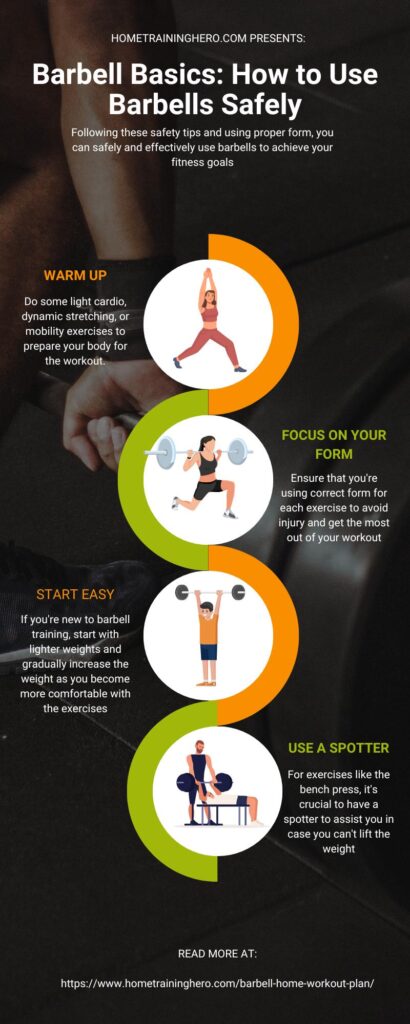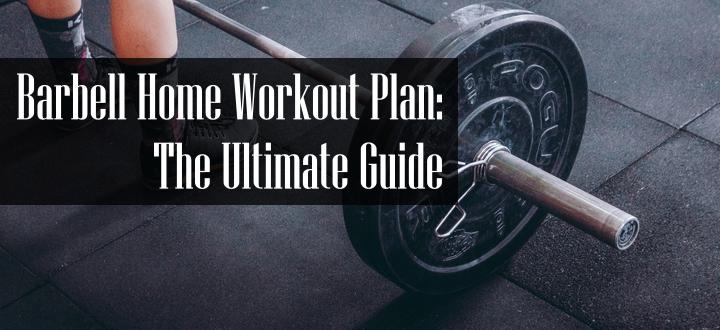Regular exercise is crucial for maintaining a healthy lifestyle. Still, busy schedules, lack of access to a gym, and other commitments can make it challenging to stick to a fitness routine.
Luckily, working out at home has become an increasingly popular option in recent years, especially with the pandemic-related restrictions on public spaces.
The barbell is one of the most effective tools for building strength and muscle at home. Barbells are versatile and can be used for a wide variety of exercises – from basic lifts like the squat and deadlift to more complex movements like the snatch and clean and jerk.
In this article, we’ll explore the basics of barbell training – and also provide you with a sample barbell home workout plan. Whether a seasoned weightlifter or a beginner, a barbell home workout plan can help you improve your strength, muscle mass, and overall fitness.
Contents
Barbell Basics
Before we get into the specifics of a barbell home workout plan, let’s start with the basics.
A barbell is a long, straight metal bar with weighted plates attached to either end. The bar is typically made of steel or another sturdy metal – and can weigh anywhere from 20 to 45 pounds on its own. The weight plates can be added or removed to adjust the overall weight of the barbell.
Barbell exercises are a staple in weightlifting and strength training. Some of the most common barbell exercises include the squat, deadlift, bench press, overhead press, and barbell row. These exercises target multiple muscle groups and are effective for building strength, muscle mass, and power.
However, caution is essential when using barbells, especially if you’re new to weightlifting. Here are some tips for using barbells safely:
- Always warm up before lifting. Do some light cardio, dynamic stretching, or mobility exercises to prepare your body for the workout.
- Use proper form. Ensure that you’re using correct form for each exercise to avoid injury and get the most out of your workout. Consider hiring a personal trainer or watching instructional videos if unsure about your form.
- Start with lighter weights. If you’re new to barbell training, start with lighter weights and gradually increase the weight as you become more comfortable with the exercises.
- Use a spotter. For exercises like the bench press, it’s crucial to have a spotter to assist you in case you can’t lift the weight.
Following these safety tips and using proper form, you can safely and effectively use barbells to achieve your fitness goals.
Now that we’ve covered the basics of barbell training let’s move on to creating a barbell home workout plan.

Creating a Barbell Home Workout Plan
A well-designed workout plan is essential for achieving your fitness goals, especially when it comes to barbell training. Here are 5 essential steps to create an effective barbell home workout plan:
- Assess your fitness level. Before starting any exercise program, it’s important to assess your current fitness level. This will help you determine your starting point and set realistic goals. You can do this by measuring your body composition, testing your strength and endurance, or consulting with a fitness professional.
- Determine your fitness goals. What do you want to achieve with your barbell home workout plan? Are you looking to build muscle mass, improve strength, or lose weight? Once you have a clear goal, you can tailor your workout plan accordingly.
- Choose exercises for your plan. Depending on your fitness goals, you’ll want to select barbell exercises that target the muscle groups you want to work. For example, if you build leg strength, you may choose exercises like squats, lunges, and deadlifts. To improve upper body strength, you may choose exercises like bench press, shoulder press, and barbell rows.
- Create a schedule. Once you’ve chosen your exercises, it’s time to create a schedule. Determine how many days per week you want to work out and which exercises you’ll do each day. You should also include rest days to allow your muscles to recover.
- Monitor your progress. Monitoring your progress regularly is essential to ensure that you’re progressing toward your fitness goals. This can include tracking your weight, measuring your body composition, or testing your strength and endurance.
By following these steps, you can create a customized barbell home workout plan that’s tailored to your fitness level and goals. In the next section, we’ll provide you with a sample barbell home workout plan to help you get started.
Sample Barbell Home Workout Plan
Here’s a sample barbell home workout plan that you can use to get started:
Day 1: Lower Body
- Barbell squats – 3 sets of 8-10 reps
- Barbell lunges – 3 sets of 8-10 reps (per leg)
- Romanian deadlifts – 3 sets of 8-10 reps
- Calf raises – 3 sets of 12-15 reps
Day 2: Upper Body
- Barbell bench press – 3 sets of 8-10 reps
- Barbell rows – 3 sets of 8-10 reps
- Barbell overhead press – 3 sets of 8-10 reps
- Pull-ups – 3 sets of max reps
Day 3: Rest
Day 4: Lower Body
- Deadlifts – 3 sets of 8-10 reps
- Barbell step-ups – 3 sets of 8-10 reps (per leg)
- Leg press – 3 sets of 12-15 reps
- Seated calf raises – 3 sets of 12-15 reps
Day 5: Upper Body
- Incline barbell bench press – 3 sets of 8-10 reps
- Bent-over barbell rows – 3 sets of 8-10 reps
- Barbell bicep curls – 3 sets of 8-10 reps
- Tricep extensions – 3 sets of 8-10 reps
Day 6: Rest
Day 7: Full Body
- Barbell squats – 3 sets of 8-10 reps
- Barbell deadlifts – 3 sets of 8-10 reps
- Barbell bench press – 3 sets of 8-10 reps
- Barbell rows – 3 sets of 8-10 reps
- Barbell overhead press – 3 sets of 8-10 reps
- Pull-ups – 3 sets of max reps
Note: Remember to warm up before each workout and stretch afterward. Use weights that challenge you, but don’t compromise your form. Rest for 1-2 minutes between sets, and stay hydrated throughout your workout.
This is just one example of a barbell home workout plan. You can adjust the exercises, sets, and reps to fit your individual fitness goals and preferences. Remember to listen to your body; if you experience any pain or discomfort, stop the exercise and consult a healthcare professional.
Tips for a Successful Barbell Home Workout
Working out at home with a barbell can be an effective and convenient way to reach your fitness goals.
Here are some tips to help you make the most out of your barbell home workout:
- Start with lighter weights. If you’re new to barbell training, start with lighter weights and focus on perfecting your form before increasing the weight. This will help prevent injuries and ensure you target the correct muscle groups.
- Focus on compound exercises. Compound exercises like squats, deadlifts, and bench press work multiple muscle groups at once, making them more efficient and effective for building strength and muscle mass.
- Incorporate progressive overload. Progressive overload means gradually increasing the weight or reps over time to continue challenging your muscles and making progress. This can help prevent plateaus and ensure that you’re making gains in strength and muscle mass.
- Take rest days. Rest is an essential component of any workout plan. Make sure to take rest days to allow your muscles to recover and avoid overtraining.
- Invest in a quality barbell and weights. A quality barbell and weights are essential for a safe and effective workout. Make sure to invest in equipment that can handle the weight you’re lifting and won’t break down over time.
By following these tips, you can ensure that your barbell home workout plan is safe, effective, and tailored to your individual fitness goals. Don’t forget to track your progress and adjust your plan as needed to continue making gains in strength and muscle mass.
Final Words
A barbell home workout plan can be an excellent way to build strength, increase muscle mass, and improve your overall fitness. With a barbell and a few key exercises, you can create a challenging and effective workout routine that you can do in the comfort of your own home.
Remember to start with lighter weights, focus on compound exercises, and incorporate progressive overload to continue making gains in strength and muscle mass. Take rest days to allow your muscles to recover – and invest in quality equipment to ensure a safe and effective workout.
As with any exercise program, it’s essential to listen to your body and consult a healthcare professional if you experience pain or discomfort. However, with dedication, consistency, and hard work, a barbell home workout plan can help you reach your fitness goals and improve your overall health and well-being.
To learn more about building strength, check out the hometraininghero.com strength training archive – LOADED with actionable fitness tips and hacks.


